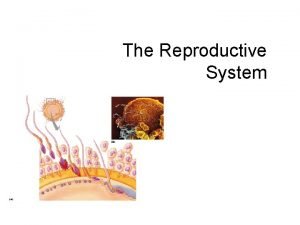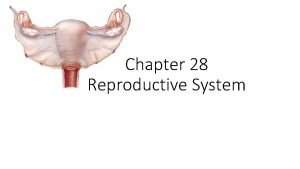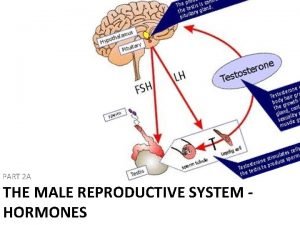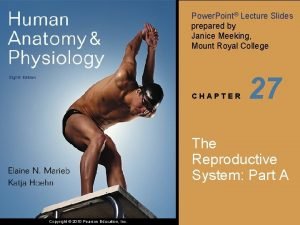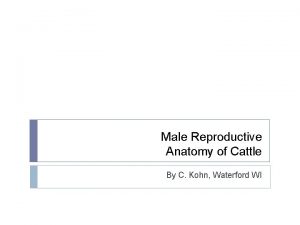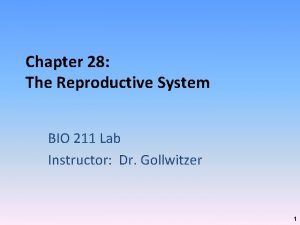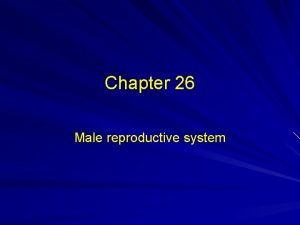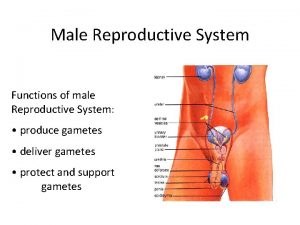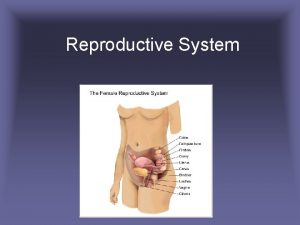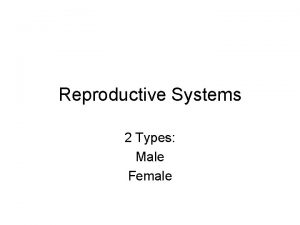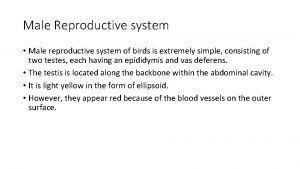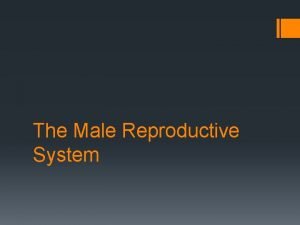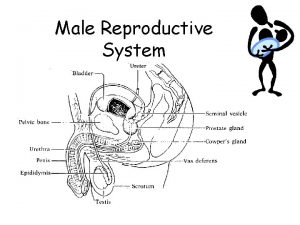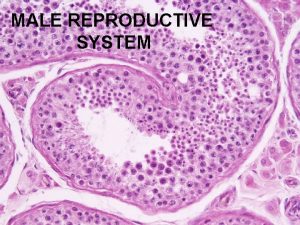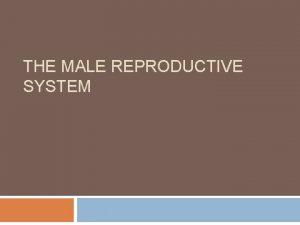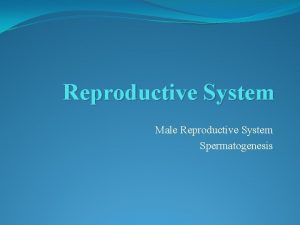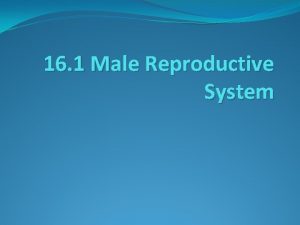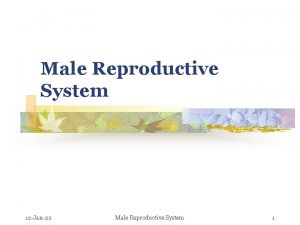Functions of Female and Male Reproductive System 1





























- Slides: 29

Functions of Female and Male Reproductive System 1. Produces, nurtures and transports gametes (sex cells) 2. Secretes hormones 3. Means for fertilization 4. Place for maturation of a zygote (female reproductive system only) Copyright © 2009 Pearson Education, Inc. , publishing as Benjamin Cummings

§ Gonads—primary sex organs § Testes in males § Ovaries in females § Function: produce gametes (sex cells) secrete hormones § (Spermatogenesis) – only in males – sperm production § (Oogenesis) – only in females – egg production Copyright © 2009 Pearson Education, Inc. , publishing as Benjamin Cummings

The Male Reproductive System Copyright © 2009 Pearson Education, Inc. , publishing as Benjamin Cummings

Divisions of the Male Reproductive System A. Testes B. Duct System C. Accessory Glands D. External Genitalia We will discuss each of these in more detail Copyright © 2009 Pearson Education, Inc. , publishing as Benjamin Cummings

A. Testes small organs that lie in the scrotum 2 Types of Cells within the testis 1. Interstitial cells: produce androgens (male hormones) such as testosterone 2. Spermatogenic: sperm-producing cells Copyright © 2009 Pearson Education, Inc. , publishing as Benjamin Cummings

B. Duct System 1. Epididymis 2. Ductus (vas) deferens 3. Ejaculatory Duct 4. Urethra Copyright © 2009 Pearson Education, Inc. , publishing as Benjamin Cummings

1. Epididymis § Comma-shaped, tightly coiled tube (20 ft) § Found on the superior part of the testis along the posterior lateral side § Functions: mature and store sperm cells (at least 20 days) § Muscles in the epididymis walls move sperm to the vas deferens (peristalsis) Copyright © 2009 Pearson Education, Inc. , publishing as Benjamin Cummings

2. Ductus Deferens (Vas Deferens) § Carries sperm from the epididymis to the ejaculatory duct § Passes over the bladder § Moves sperm by peristalsis Copyright © 2009 Pearson Education, Inc. , publishing as Benjamin Cummings

3. Ejaculatory Duct § Unites the ductus deferens with the urethra Copyright © 2009 Pearson Education, Inc. , publishing as Benjamin Cummings Urinary Bladder

4. Urethra § Extends from the base of the urinary bladder to the tip of the penis § Carries both urine and sperm § Sperm enters from the ejaculatory duct Copyright © 2009 Pearson Education, Inc. , publishing as Benjamin Cummings

Figure 16. 2 b Copyright © 2009 Pearson Education, Inc. , publishing as Benjamin Cummings

C. Accessory Organs 1. Seminal vesicles – located at base of bladder, secretes substances that nourish the sperm (fructose, prostaglandins) 2. Prostate – surrounds upper part of urethra, secretes milky fluid that activates sperm 3. Bulbourethral glands (Cowper)- small, inferior to prostate, produces mucus that cleans and lubricates urethra Copyright © 2009 Pearson Education, Inc. , publishing as Benjamin Cummings

Figure 16. 2 a Copyright © 2009 Pearson Education, Inc. , publishing as Benjamin Cummings

Semen § Mixture of sperm and accessory gland secretions § Advantages of accessory gland secretions § Fructose provides energy for sperm cells § Alkalinity of semen helps neutralize the acidic environment of vagina § Semen inhibits bacterial growth § Elements of semen enhance sperm motility 2 -6 ml per ejaculate Average 180 million sperm Copyright © 2009 Pearson Education, Inc. , publishing as Benjamin Cummings

D. External Genitalia 1. Scrotum 2. Penis Copyright © 2009 Pearson Education, Inc. , publishing as Benjamin Cummings

1. Scrotum § Divided sac of skin outside the abdomen § Maintains testes at 3°C lower than normal body temperature to protect sperm viability § Muscles move testes up toward body or lower away from body Copyright © 2009 Pearson Education, Inc. , publishing as Benjamin Cummings

2. Penis § Delivers sperm into the female reproductive tract Copyright © 2009 Pearson Education, Inc. , publishing as Benjamin Cummings

Figure 16. 2 a Copyright © 2009 Pearson Education, Inc. , publishing as Benjamin Cummings

Female Reproductive System Copyright © 2009 Pearson Education, Inc. , publishing as Benjamin Cummings

Female Reproductive System A. Ovaries B. Duct System 1. Uterine tubes (fallopian tubes) 2. Uterus 3. Vagina C. External genitalia Copyright © 2009 Pearson Education, Inc. , publishing as Benjamin Cummings

A. Ovaries § Composed of ovarian follicles (liquid-filled saclike structures) § Each follicle consists of - Oocyte (immature egg) Copyright © 2009 Pearson Education, Inc. , publishing as Benjamin Cummings

B. Duct System 1. Uterine tubes (fallopian tubes) 2. Uterus 3. Vagina Copyright © 2009 Pearson Education, Inc. , publishing as Benjamin Cummings

1. Uterine (Fallopian) Tubes § Receive the ovulated oocyte § Provide a site for fertilization (egg + sperm) § Attach to the uterus, supported by ligaments Copyright © 2009 Pearson Education, Inc. , publishing as Benjamin Cummings

2. Uterus § Located between the urinary bladder and rectum § Hollow organ § Functions of the uterus § Prepares for possible pregnancy § Receives a fertilized egg § Retains the fertilized egg § Nourishes the fertilized egg (oxygen and nutrients) Copyright © 2009 Pearson Education, Inc. , publishing as Benjamin Cummings

Walls of the Uterus § Endometrium § Inner layer § Allows for implantation of a fertilized egg § Sloughs off if no pregnancy occurs (menses or menstruation) § Myometrium—middle layer of smooth muscle § Perimetrium (visceral peritoneum)—outermost serous layer of the uterus (see text for diagram p 555) Copyright © 2009 Pearson Education, Inc. , publishing as Benjamin Cummings

Cervix § —narrow outlet of uterus that protrudes into the vagina § distal end of the uterus § Opening for sperm into the uterus § Dilates for childbirth Copyright © 2009 Pearson Education, Inc. , publishing as Benjamin Cummings

3. Vagina § Tube from cervix to exterior of body § Located between bladder and rectum § Serves as the birth canal § Passage for menses (menstruation) § Receives the penis during sexual intercourse § Hymen— vascular mucosa, partially closes the vagina until it is ruptured Copyright © 2009 Pearson Education, Inc. , publishing as Benjamin Cummings

4. External Genitalia (Vulva) A. Mons pubis – fat over pubic symphsis B. Labia – skin folds (majora and minora) C. Greater vestibular glands – each side of vagina, secretes lubricating fluid D. Clitoris – erectile tissue E. Orfices - vaginal and urethral Copyright © 2009 Pearson Education, Inc. , publishing as Benjamin Cummings

External Genitalia (Vulva) Figure 16. 9 Copyright © 2009 Pearson Education, Inc. , publishing as Benjamin Cummings
 Development of female reproductive system
Development of female reproductive system Parts of male and female reproductive system
Parts of male and female reproductive system Similarities between male and female reproductive system
Similarities between male and female reproductive system 90/2
90/2 Prepuce
Prepuce Cartilaginous fish reproduction
Cartilaginous fish reproduction Oviduct funnel
Oviduct funnel Function of reproductive organs
Function of reproductive organs Female reproductive system functions
Female reproductive system functions Ducts in female reproductive system
Ducts in female reproductive system Function of male reproductive system
Function of male reproductive system What are primary sexual characteristics
What are primary sexual characteristics Male reproductive system from front
Male reproductive system from front Exercise 42 anatomy of the reproductive system
Exercise 42 anatomy of the reproductive system Oogenesis process
Oogenesis process Female external reproductive system
Female external reproductive system Luteinizing hormone in male reproductive system
Luteinizing hormone in male reproductive system Male plant reproductive system
Male plant reproductive system Art-labeling activity: the male reproductive system, part 1
Art-labeling activity: the male reproductive system, part 1 Male reproductive system information
Male reproductive system information Male reproductive system produces sperm cells
Male reproductive system produces sperm cells Male reproductive system
Male reproductive system Male genital anatomy front view
Male genital anatomy front view Examples of asexual reproduction
Examples of asexual reproduction Function of male reproductive system
Function of male reproductive system Fertilization in pila
Fertilization in pila Fetal pig female reproductive system
Fetal pig female reproductive system Female part of a flower
Female part of a flower Figure 28-1 the male reproductive system
Figure 28-1 the male reproductive system Primary sex organ of the male reproductive system? *
Primary sex organ of the male reproductive system? *


